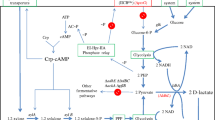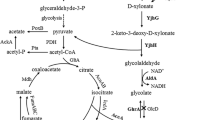Abstract
The efficient utilization of xylose is regarded as a technical barrier to the commercial production of bulk chemicals from biomass. Due to the desirable mechanical properties of polylactic acid (PLA) depending on the isomeric composition of lactate, biotechnological production of lactate with high optical pure has been increasingly focused in recent years. The main objective of this work was to construct an engineered Escherichia coli for the optically pure l-lactate production from xylose. Six chromosomal deletions (pflB, ldhA, ackA, pta, frdA, adhE) and a chromosomal integration of l-lactate dehydrogenase-encoding gene (ldhL) from Bacillus coagulans was involved in construction of E. coli KSJ316. The recombinant strain could produce l-lactate from xylose resulting in a yield of 0.91 g/g xylose. The chemical purity of l-lactate was 95.52%, and the optical purity was greater than 99%. Moreover, three strategies, including overexpression of l-lactate dehydrogenase, intensification of xylose catabolism, and addition of additives to medium, were designed to enhance the production. The results showed that they could increase the concentration of l-lactate by 32.90, 20.13, and 233.88% relative to the control, respectively. This was the first report that adding formate not only could increase the xylose utilization but also led to the fewer by-product levels.



Similar content being viewed by others
References
Limayem, A., & Ricke, S. C. (2012). Lignocellulosic biomass for bioethanol production: current perspectives, potential issues and future prospects. Progress in Energy and Combustion Science, 38, 449–467.
Oh, H., Wee, Y.-J., Yun, J.-S., Han, S. H., Jung, S., & Ryu, H.-W. (2005). Lactic acid production from agricultural resources as cheap raw materials. Bioresource Technology, 96, 1492–1498.
Cardona, C. A., & Sánchez, Ó. J. (2007). Fuel ethanol production: process design trends and integration opportunities. Bioresource Technology, 98, 2415–2457.
Gírio, F. M., Fonseca, C., Carvalheiro, F., Duarte, L. C., Marques, S., & Bogel-Łukasik, R. (2010). Hemicelluloses for fuel ethanol: a review. Bioresource Technology, 101, 4775–4800.
John, R. P., Nampoothiri, K. M., & Pandey, A. (2007). Fermentative production of lactic acid from biomass: an overview on process developments and future perspectives. Applied Microbiology and Biotechnology, 74, 524–534.
Datta, R., & Henry, M. (2006). Lactic acid: recent advances in products, processes and technologies—a review. Journal of Chemical Technology and Biotechnology, 81, 1119–1129.
Ji, X.-J., Huang, H., Nie, Z.-K., Qu, L., Xu, Q., & Tsao, G. T. (2011). Fuels and chemicals from hemicellulose sugars. Biotechnology in China III: Biofuels and Bioenergy, Springer, pp. 199–224.
Södergård, A., & Stolt, M. (2002). Properties of lactic acid based polymers and their correlation with composition. Progress in Polymer Science, 27, 1123–1163.
Saito, K., Hasa, Y., & Abe, H. (2012). Production of lactic acid from xylose and wheat straw by Rhizopus oryzae. Journal of Bioscience and Bioengineering, 114, 166–169.
Maas, R. H. W., Bakker, R. R., Eggink, G., & Weusthuis, R. A. (2006). Lactic acid production from xylose by the fungus Rhizopus oryzae. Applied Microbiology and Biotechnology, 72, 861–868.
Abdel-Rahman, M. A., Tashiro, Y., & Sonomoto, K. (2011). Lactic acid production from lignocellulose-derived sugars using lactic acid bacteria: overview and limits. Journal of Biotechnology, 156, 286–301.
Ohara, H., Owaki, M., & Sonomoto, K. (2006). Xylooligosaccharide fermentation with Leuconostoc lactis. Journal of Bioscience and Bioengineering, 101, 415–420.
Moldes, A., Torrado, A., Converti, A., & Dominguez, J. (2006). Complete bioconversion of hemicellulosic sugars from agricultural residues into lactic acid by Lactobacillus pentosus. Applied Biochemistry and Biotechnology, 135, 219–227.
Ye, L., Zhou, X., Hudari, M. S. B., Li, Z., & Wu, J. C. (2013). Highly efficient production of L-lactic acid from xylose by newly isolated Bacillus coagulans C106. Bioresource Technology, 132, 38–44.
Jiang, T., Qiao, H., Zheng, Z., Chu, Q., Li, X., Yong, Q., & Ouyang, J. (2016). Lactic acid production from pretreated hydrolysates of corn stover by a newly developed Bacillus coagulans strain. PloS One, 11, e0149101.
Keseler, I. M., Collado-Vides, J., Gama-Castro, S., Ingraham, J., Paley, S., Paulsen, I. T., Peralta-Gil, M., & Karp, P. D. (2005). EcoCyc: a comprehensive database resource for Escherichia coli. Nucleic Acids Research, 33, D334–D337.
Trinh, C. T., Unrean, P., & Srienc, F. (2008). Minimal Escherichia coli cell for the most efficient production of ethanol from hexoses and pentoses. Applied and Environmental Microbiology, 74, 3634–3643.
Dien, B., Nichols, N., & Bothast, R. (2001). Recombinant Escherichia coli engineered for production of L-lactic acid from hexose and pentose sugars. Journal of Industrial Microbiology and Biotechnology, 27, 259–264.
Zhou, S., Shanmugam, K., & Ingram, L. (2003). Functional replacement of the Escherichia coli D-(−)-lactate dehydrogenase gene (ldhA) with the L-(+)-lactate dehydrogenase gene (ldhL) from Pediococcus acidilactici. Applied and Environmental Microbiology, 69, 2237–2244.
Zhao, J., Xu, L., Wang, Y., Zhao, X., Wang, J., Erin, G., Ryan, M., & Zhou, S. (2013). Homofermentative production of optically pure L-lactic acid from xylose by genetically engineered Escherichia coli B. Microbial Cell Factories, 12, 1–6.
Jiang, T., Xu, Y., Sun, X., Zheng, Z., & Ouyang, J. (2014). Kinetic characterization of recombinant Bacillus coagulans FDP-activated l-lactate dehydrogenase expressed in Escherichia coli and its substrate specificity. Protein Expression and Purification, 95, 219–225.
Liu, R., Liang, L., Chen, K., Ma, J., Jiang, M., Wei, P., & Ouyang, P. (2012). Fermentation of xylose to succinate by enhancement of ATP supply in metabolically engineered Escherichia coli. Applied Microbiology and Biotechnology, 94, 959–968.
Ouyang, J., Cai, C., Chen, H., Jiang, T., & Zheng, Z. (2012). Efficient non-sterilized fermentation of biomass-derived xylose to lactic acid by a thermotolerant Bacillus coagulans NL01. Applied Biochemistry and Biotechnology, 168, 2387–2397.
Sambrook, J., Fritsch, E. F., & Maniatis, T. (1989). Molecular cloning: a laboratory manual. ed., Cold Spring Harbor Laboratory Press.
Bloor, A. E., & Cranenburgh, R. M. (2006). An efficient method of selectable marker gene excision by Xer recombination for gene replacement in bacterial chromosomes. Applied and Environmental Microbiology, 72, 2520–2525.
Zheng, Z., Lin, X., Jiang, T., Ye, W., & Ouyang, J. (2016). Genomic analysis of a xylose operon and characterization of novel xylose isomerase and xylulokinase from Bacillus coagulans. Biotechnology Letters, 38, 1331–1339.
Sánchez, A. M., Bennett, G. N., & San, K.-Y. (2005). Effect of different levels of NADH availability on metabolic fluxes of Escherichia coli chemostat cultures in defined medium. Journal of Biotechnology, 117, 395–405.
Liang, L., Liu, R., Wang, G., Gou, D., Ma, J., Chen, K., Jiang, M., Wei, P., & Ouyang, P. (2012). Regulation of NAD (H) pool and NADH/NAD+ ratio by overexpression of nicotinic acid phosphoribosyltransferase for succinic acid production in Escherichia coli NZN111. Enzyme and Microbial Technology, 51, 286–293.
Kim, Y., Ingram, L. O., & Shanmugam, K. T. (2007). Construction of an Escherichia coli K-12 mutant for homoethanologenic fermentation of glucose or xylose without foreign genes. Applied and Environmental Microbiology, 73, 1766–1771.
Patel, M. A., Ou, M. S., Harbrucker, R., Aldrich, H. C., Buszko, M. L., Ingram, L. O., & Shanmugam, K. T. (2006). Isolation and characterization of acid-tolerant, thermophilic bacteria for effective fermentation of biomass-derived sugars to lactic acid. Applied and Environmental Microbiology, 72, 3228–3235.
Tian, K., Chen, X., Shen, W., Prior, B. A., Shi, G., Singh, S., & Wang, Z. (2012). High-efficiency conversion of glycerol to D-lactic acid with metabolically engineered Escherichia coli. African Journal of Biotechnology, 11, 4860–4867.
Berríos-Rivera, S. J., Bennett, G. N., & San, K.-Y. (2002). Metabolic engineering of Escherichia coli: increase of NADH availability by overexpressing an NAD+-dependent formate dehydrogenase. Metabolic Engineering, 4, 217–229.
San, K.-Y., Bennett, G. N., Berrıíos-Rivera, S. J., Vadali, R. V., Yang, Y.-T., Horton, E., Rudolph, F. B., Sariyar, B., & Blackwood, K. (2002). Metabolic engineering through cofactor manipulation and its effects on metabolic flux redistribution in Escherichia coli. Metabolic Engineering, 4, 182–192.
Balzer, G. J., Thakker, C., Bennett, G. N., & San, K.-Y. (2013). Metabolic engineering of Escherichia coli to minimize byproduct formate and improving succinate productivity through increasing NADH availability by heterologous expression of NAD+-dependent formate dehydrogenase. Metabolic Engineering, 20, 1–8.
Müller, R. H., Markuske, K. D., & Babel, W. (1985). Formate gradients as a means for detecting the maximum carbon conversion efficiency of heterotrophic substrates: correlation between formate utilization and biomass increase. Biotechnology and Bioengineering, 27, 1599–1602.
Sawers, R. (2005). Formate and its role in hydrogen production in Escherichia coli. Biochemical Society Transactions, 33, 42–46.
Acknowledgements
This study was supported by the Major Program of the Natural Science Foundation of Jiangsu Higher Education of China (16KJA220004) and the National Natural Science Foundation of China (51561145015). We also kindly acknowledge partial support from the Priority Academic Program Development of Jiangsu Higher Education Institutions (PAPD).
Author information
Authors and Affiliations
Contributions
Conceived and designed the experiments: JO ZZ TJ. Performed the experiments: TJ CZ. Analyzed the data: QH ZZ JO. Contributed reagents/materials/analysis tools: ZZ JO. Wrote the paper: TJ ZZ JO.
Corresponding author
Ethics declarations
Conflict of Interest
The authors declare that there is no conflict of interest.
Electronic Supplementary Material
Figure S1
(DOC 56 kb)
Rights and permissions
About this article
Cite this article
Jiang, T., Zhang, C., He, Q. et al. Metabolic Engineering of Escherichia coli K12 for Homofermentative Production of l-Lactate from Xylose. Appl Biochem Biotechnol 184, 703–715 (2018). https://doi.org/10.1007/s12010-017-2581-6
Received:
Accepted:
Published:
Issue Date:
DOI: https://doi.org/10.1007/s12010-017-2581-6




